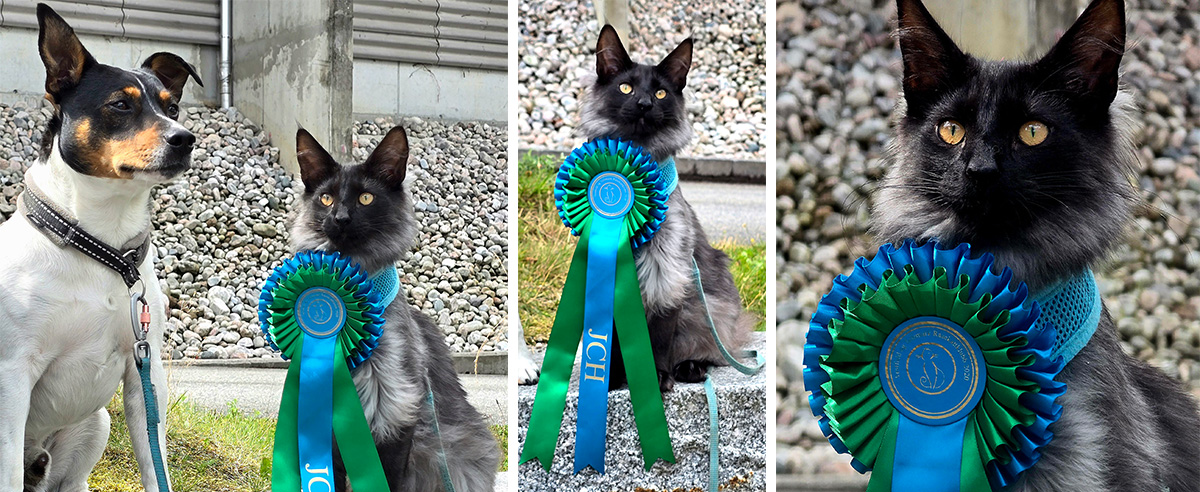Understanding your cat’s undercoat and and how to keep it healthy.
When a cat develops mats or tangles, the problem usually starts in the undercoat — often due to poor grooming, or because of snow, grass, twigs, a harness, and similar things.
Here’s a guide to what the undercoat is, how neutering affects it, and how you can help your cat maintain a soft, healthy, and shiny coat.
What Is the Undercoat?
The undercoat is the soft, dense layer of fur beneath the guard hairs.
It serves as insulation against cold and helps your cat regulate body temperature.
-
Longhaired breeds such as the Norwegian Forest Cat, Maine Coon, and Siberian have a thick undercoat.
-
Shorthaired breeds such as the Siamese and Abyssinian have little or none.
-
Rex cats have a curly or reduced undercoat.
-
Sphynx cats lack it entirely.
Outdoor cats often grow a seasonal undercoat – thick in winter and thin in summer – while indoor cats live in stable temperatures and develop a more consistent coat year-round.
What Affects the Amount of Undercoat?
The quantity and quality of your cat’s undercoat depend on several factors:
-
Climate: Cold weather stimulates undercoat growth. Indoor cats usually have a thinner undercoat.
-
Genetics and breed: Some breeds are naturally adapted to cold climates and grow thicker coats.
-
Light and hormones: Shorter days in autumn trigger fur growth through the hormone melatonin.
-
Diet: Protein and fatty acids are the building blocks of healthy skin and fur.
-
Health and stress: Hormonal changes, illness, or stress can weaken the coat.
-
Grooming and environment: Brushing, humidity, and general well-being make a big difference.
Neutering and Coat Changes
Neutering affects hormone levels – and therefore the texture and growth of your cat’s fur.
Male Cats
Before neutering, male cats often have coarser and greasier fur due to testosterone.
After neutering:
-
The coat becomes softer and smoother
-
The undercoat thickens
-
The greasy texture diminishes
Result: a fluffier, softer coat with more undercoat growth.
Female Cats
Female cats usually experience milder changes. Estrogen affects hair growth cycles, and after neutering:
-
The coat becomes more stable and consistent throughout the year
-
The undercoat may become slightly thicker
-
Shedding decreases
Result: a smooth, glossy coat with fewer hormone-driven shedding periods.
How to Strengthen the Undercoat
1. Brush Regularly
-
Stimulates hair follicles and improves circulation
-
Removes loose fur and reduces tangles
-
Use a brush that reaches the undercoat
Tips:
Longhaired cats → brush 3–5 times per week
Shorthaired cats → brush 1–2 times per week
2. Provide Proper Nutrition
A healthy coat starts from within.
-
Protein: The foundation for strong hair. Choose food with high meat content.
-
Fatty acids: Omega-3 and -6 improve shine and elasticity. Salmon oil is excellent.
-
Vitamins: Biotin, zinc, and vitamins A & E support hair and skin health.
A quality cat food usually covers these needs, but extra biotin can help if the coat looks dull or during heavy shedding.
3. Environment and Well-Being
- Reduce stress with steady routines, calm surroundings, and safe resting places..
Water helps maintain skin moisture and fur elasticity.
Use a cat fountain or feed wet/raw food to increase water intake.
5. Avoid Common Grooming Mistakes
-
Bathe your cat when necessary – the right care products can make grooming easier.
-
Never use human shampoo.
-
Prevent obesity – poor circulation weakens coat quality.
Summary
| Factor | Effect on the Undercoat |
|---|---|
| Climate | Cold = thicker undercoat |
| Genetics | Breed determines density |
| Neutering | Usually softer, thicker coat |
| Diet | Good nutrition = strong coat |
| Grooming & environment | Brushing + comfort = healthy undercoat |
The undercoat is your cat’s natural protection – and your care makes all the difference.
With proper grooming, nutrition, and a stress-free environment, you can help your cat stay soft, healthy, and beautiful all year round.


